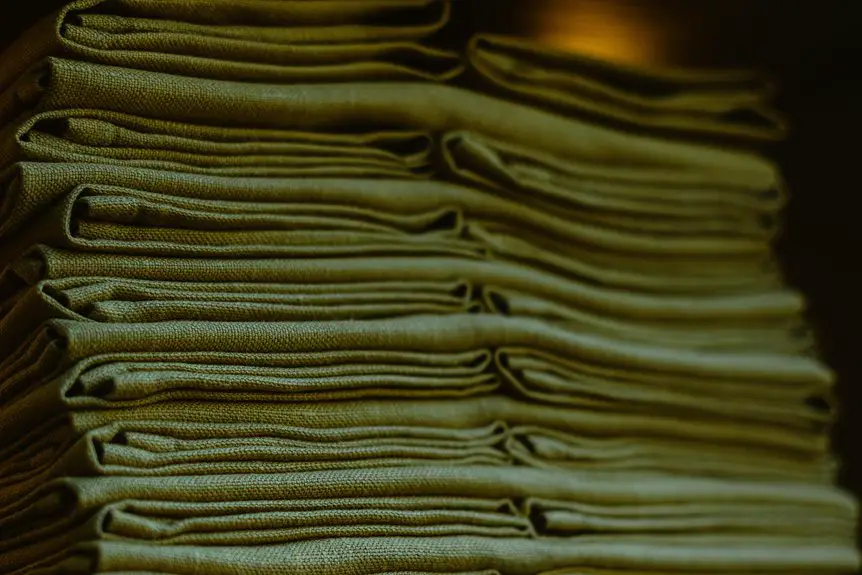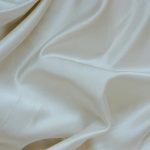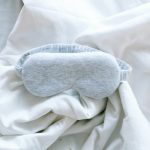Cotton-rich percale blends mostly cotton (60-80%) with synthetic fibers, giving you the soft, breathable feel of cotton plus extra strength and wrinkle resistance. Thanks to its crisp, matte weave, it stays cool and durable—perfect for bedding or light clothing. It washes well, feels classic, and breathes better than satin weaves. If you want to understand how it’s made, used, and cared for, there’s more to explore about this fabric’s qualities and impact.
Table of Contents
Key Takeaways
- Cotton-rich percale is a fabric blend containing 60%-80% cotton combined with synthetic fibers for enhanced durability and wrinkle resistance.
- It features a crisp, smooth percale weave with a matte finish, offering excellent breathability and a cool feel.
- The blend balances softness and strength, maintaining shape longer and drying faster than 100% cotton percale.
- Cotton-rich percale is ideal for bedding and lightweight clothing, providing easy care and long-lasting quality.
- While offering practical benefits, its environmental impact depends on cotton sourcing and synthetic fiber use in production.
Defining Percale Weave
Percale weave creates a crisp, smooth fabric by tightly interlacing threads in a simple one-over, one-under pattern.
Percale weave forms a crisp, smooth fabric through a tight, classic one-over, one-under thread pattern.
When you touch percale, you’ll notice its matte finish and cool, breathable feel, making it perfect for bedding and apparel. This weave’s tight construction boosts durability and helps fabric resist pilling, so your sheets stay fresh longer.
You can expect a lightweight material that’s easy to care for and gains softness with each wash. Unlike satin weaves that shine, percale’s texture is understated but elegant, offering a classic look.
Whether you’re choosing sheets or clothing, understanding percale weave helps you pick fabrics that balance comfort, strength, and breathability, giving you a reliable, everyday option that feels great against your skin.
The Composition of Cotton-Rich Fabrics
When you choose cotton-rich fabrics, you’re opting for a blend that combines natural softness with enhanced durability. Typically, these fabrics contain a high percentage of cotton—often around 60% to 80%—mixed with synthetic fibers like polyester.
This mix gives you the breathability and comfort of cotton, while the synthetics add strength, wrinkle resistance, and color retention. You might also find small amounts of other fibers, such as rayon or lycra, to improve stretch or texture.
The exact ratio varies depending on the intended use of the fabric. By understanding this composition, you can better appreciate why cotton-rich fabrics offer a balanced combination of comfort, longevity, and easy care, making them ideal for everyday bedding and clothing.
How Cotton-Rich Percale Is Manufactured
You start by carefully selecting high-quality cotton fibers to guarantee softness and durability.
Then, the weaving process uses a tight, plain weave technique that gives percale its crisp texture.
Understanding these steps helps you appreciate the craftsmanship behind cotton-rich percale fabrics.
Fiber Selection Process
Although selecting the right fibers might seem straightforward, it plays an essential role in guaranteeing the quality of cotton-rich percale. You need to carefully choose fibers that balance softness, durability, and breathability.
Here’s how you approach it:
- Evaluate Cotton Quality: Pick long-staple cotton for a smoother, stronger fabric. The fiber length affects the percale’s feel and longevity.
- Blend Proportions: Decide the percentage of cotton versus synthetic fibers. A higher cotton content guarantees breathability, while synthetics add wrinkle resistance and durability.
- Check Fiber Purity: Avoid impurities or damaged fibers which can weaken the fabric and affect its appearance.
Weaving Techniques Used
Choosing the right fibers sets the foundation, but the weaving technique shapes the final texture and strength of cotton-rich percale. This fabric uses a plain weave, where each weft thread crosses over and under each warp thread alternately.
This tight, one-over-one-under pattern creates a smooth, crisp surface that feels cool and breathable against your skin. The high thread count achieved through this weaving method enhances durability without sacrificing softness.
Manufacturers maintain consistent tension during weaving to prevent irregularities, ensuring the fabric holds its shape well over time.
When you pick cotton-rich percale, you’re choosing a fabric crafted with precision weaving that balances strength and comfort, making it ideal for bedding and apparel that lasts and feels great.
Benefits of Cotton in Bedding Fabrics
Because cotton fibers naturally wick moisture and allow air to circulate, they keep your bedding cool and comfortable throughout the night.
When you choose cotton-rich bedding, you benefit in several ways:
- Breathability: Cotton lets air flow freely, preventing overheating and promoting restful sleep.
- Softness: Cotton fibers feel gentle against your skin, enhancing comfort.
- Durability: Cotton withstands repeated washing without losing shape or softness, making your bedding last longer.
These benefits mean you’ll enjoy a fresh, cozy sleeping environment every night.
Experience the comfort of a fresh, cozy sleeping space night after night.
Cotton’s natural properties help regulate temperature and reduce irritation, so you wake up feeling refreshed.
Choosing bedding with a high cotton content guarantees you get both comfort and longevity in your linens.
Characteristics of Percale Fabric
You’ll notice percale fabric has a crisp, smooth texture thanks to its tight, plain weave.
It’s designed to be breathable, keeping you cool throughout the night.
Plus, its durability means it stands up well to frequent washing and everyday use.
Weave and Texture
The crisp feel of percale fabric comes from its distinctive plain weave, where threads cross over and under each other in a simple, tight pattern. This structure gives you a smooth, matte finish without any shine.
When you touch percale, you’ll notice how it feels cool and light, making it perfect for everyday bedding.
Here’s what you can expect from percale’s weave and texture:
- Tight Weave: High thread count with threads woven closely for durability and smoothness.
- Matte Surface: Unlike sateen, percale has a non-glossy, flat finish.
- Lightweight Feel: The weave keeps it breathable yet crisp, so it doesn’t cling to your skin.
This texture makes percale fabrics feel fresh and clean every time you use them.
Breathability and Durability
Although percale fabric feels lightweight and crisp, it offers impressive breathability that keeps you cool throughout the night. Its tight weave still allows air to flow freely, preventing heat and moisture buildup. This means you won’t wake up feeling sweaty or uncomfortable, making percale an excellent choice for warm sleepers or humid climates.
Beyond breathability, percale is also known for its durability. The closely woven threads create a strong, long-lasting fabric that resists pilling and tears.
When you invest in cotton-rich percale, you get bedding that maintains its crisp feel and smooth texture wash after wash. So, you can enjoy both comfort and resilience, knowing your sheets will hold up through regular use without losing their quality.
Comparing Cotton-Rich Percale to 100% Cotton Percale
When choosing between cotton-rich percale and 100% cotton percale, you’ll notice distinct differences in feel, durability, and care.
Cotton-rich percale blends cotton with synthetic fibers, offering a balance of softness and strength, while 100% cotton percale delivers a natural, crisp texture.
Here’s what to reflect on:
- Feel: 100% cotton feels cool and smooth; cotton-rich often feels slightly less natural but more wrinkle-resistant.
- Durability: Cotton-rich blends tend to resist wear better and maintain shape longer than pure cotton.
- Care: Cotton-rich fabrics usually dry faster and wrinkle less, making them easier to maintain compared to 100% cotton, which may need more delicate handling.
Knowing these differences helps you pick the best fabric for your needs.
Breathability and Comfort Features
Since breathability plays a key role in your comfort while sleeping, understanding how cotton-rich percale performs can help you make a better choice.
Cotton-rich percale fabrics combine natural cotton’s breathability with other fibers that may enhance softness or texture. This blend allows air to flow freely, helping you stay cool and dry throughout the night.
You’ll notice that cotton-rich percale feels crisp and lightweight, making it ideal for warmer climates or if you tend to sleep hot. The fabric’s smooth, matte finish also reduces clinginess, which adds to your overall comfort.
While pure cotton excels in breathability, the cotton-rich blend still offers excellent airflow without sacrificing the fabric’s durability or feel, giving you a balanced sleeping experience.
Durability and Maintenance Tips
Beyond breathability, you’ll want to contemplate how well cotton-rich percale holds up over time and how to care for it properly.
This fabric blend offers strong durability, but proper maintenance guarantees it lasts longer and stays looking fresh.
Here are three tips to keep in mind:
- Wash in cold or warm water with mild detergent to prevent shrinking and maintain fabric integrity.
- Avoid high heat when drying; opt for low heat or air-drying to protect fibers and reduce wrinkles.
- Iron on a medium setting if needed, but always check the care label to avoid damage.
Ideal Uses for Cotton-Rich Percale
Cotton-rich percale suits a variety of uses thanks to its crisp texture and breathable nature.
Cotton-rich percale offers a crisp, breathable fabric perfect for versatile, comfortable, and durable applications.
You’ll find it ideal for bedding, especially if you prefer sheets that feel cool and fresh against your skin. Its durability also makes it perfect for everyday use, standing up well to frequent washing.
Beyond bedding, cotton-rich percale works great for lightweight clothing like shirts and dresses, offering comfort without sacrificing structure.
If you want curtains or table linens that hold their shape and resist wrinkles, this fabric fits the bill.
Its matte finish provides a clean, classic look that’s easy to style.
How to Identify Quality Cotton-Rich Percale
Knowing where and how to use cotton-rich percale is just the start—you’ll want to recognize quality when you see it.
Here’s how to identify high-quality cotton-rich percale fabric:
- Check the thread count: Look for a thread count between 180 and 200. This range guarantees a crisp, durable fabric without being too heavy or stiff.
- Feel the texture: Quality percale should feel smooth and cool to the touch, with a matte finish rather than a shiny surface.
- Examine the weave: Inspect the fabric closely. A tight, even plain weave indicates quality craftsmanship and durability.
Environmental Impact of Cotton-Rich Percale
When you choose cotton-rich percale, it’s important to contemplate how sustainable the cotton fibers are and the impact synthetic blends might’ve on the environment.
You’ll also want to look for eco-friendly production practices that reduce waste and chemical use. Understanding these factors helps you make a greener choice without sacrificing quality.
Sustainability of Cotton Fibers
Although cotton fibers offer comfort and breathability, their environmental footprint can be significant if not managed responsibly.
When you choose cotton-rich percale, consider how sustainable practices can reduce harm and support the planet. Here are three key factors to keep in mind:
- Water Usage: Conventional cotton farming consumes large amounts of water, so look for cotton grown with efficient irrigation or rain-fed methods.
- Pesticide Use: Organic cotton avoids harmful chemicals, protecting ecosystems and reducing health risks for farmers.
- Soil Health: Crop rotation and regenerative farming techniques maintain soil fertility and reduce erosion, ensuring long-term sustainability.
Impact of Synthetic Blends
Since many cotton-rich percale fabrics include synthetic blends, you should understand how these materials affect the environment.
Synthetic fibers like polyester and nylon derive from petroleum, a non-renewable resource. Their production consumes significant energy and releases greenhouse gases, contributing to climate change.
When you wash these fabrics, tiny microplastics shed and enter waterways, harming marine life and ecosystems. Unlike natural fibers, synthetic blends don’t biodegrade easily, which means they persist in landfills for decades.
While adding synthetics can improve durability and reduce wrinkles, you should weigh these benefits against their environmental costs. Being aware of the impact helps you make informed choices, especially if you want to reduce your ecological footprint without sacrificing fabric quality.
Eco-friendly Production Practices
Because eco-friendly production practices play an essential role in reducing the environmental impact of cotton-rich percale, you should look for manufacturers that prioritize sustainable methods.
These practices not only protect the planet but also guarantee higher quality and safer fabrics. When choosing cotton-rich percale, consider these eco-friendly approaches:
- Organic Cotton Farming – Avoids harmful pesticides and uses less water, preserving soil health.
- Low-impact Dyeing – Utilizes natural or water-saving dyes to reduce toxic runoff.
- Recycling and Waste Reduction – Implements processes that minimize fabric waste and promote recycling.
Styling and Care Recommendations for Cotton-Rich Percale Bedding
When you choose cotton-rich percale bedding, styling it to complement your space becomes effortless due to its crisp texture and matte finish. You can pair it with sleek, modern decor or cozy, rustic elements for a versatile look. For care, machine wash in cold water, use mild detergent, and tumble dry on low heat to maintain its softness and durability.
| Styling Tip | Care Instruction | Benefit |
|---|---|---|
| Pair with neutral tones | Wash in cold water | Retains fabric integrity |
| Layer with textured throws | Use mild detergent | Preserves color and feel |
| Incorporate natural fibers | Tumble dry low heat | Prevents shrinkage |
| Add Crisp Pillows | Avoid bleach | Extends fabric life |
| Use Minimalist Decor | Iron on low if needed | Keeps smooth appearance |
Frequently Asked Questions
Can Cotton-Rich Percale Fabric Cause Allergies?
You usually won’t have allergies from cotton-rich percale fabric since it’s mostly natural fibers. However, if you’re sensitive to certain dyes or finishes used in manufacturing, it might trigger irritation or allergic reactions occasionally.
Is Cotton-Rich Percale Suitable for Summer and Winter?
You’ll find cotton-rich percale great for summer because it’s breathable and cool. In winter, layering helps since it’s less insulating, but its durability and softness make it a versatile choice year-round.
How Does Cotton-Rich Percale Compare Price-Wise to Other Fabrics?
You’ll find cotton-rich percale usually priced moderately—more affordable than pure cotton but pricier than synthetic fabrics. It balances quality and cost, giving you a durable, breathable option without breaking the bank compared to luxury textiles.
Can Cotton-Rich Percale Be Used for Clothing as Well as Bedding?
You can definitely use cotton-rich percale for clothing, especially shirts or lightweight garments. It’s breathable and crisp, making it comfortable to wear, though it’s more commonly favored for bedding due to its durability and texture.
Are There Different Thread Counts Available in Cotton-Rich Percale?
You’ll find cotton-rich percale comes in various thread counts, usually between 200 and 400. Higher counts mean a denser weave, giving you smoother, more durable fabric that feels crisp and breathable for bedding or clothing.
- Does Chiffon Fabric Stink - July 15, 2025
- Does Chiffon Fabric Affect the Economy - July 15, 2025
- Does Cotton Fabric Have a Nap - July 15, 2025







